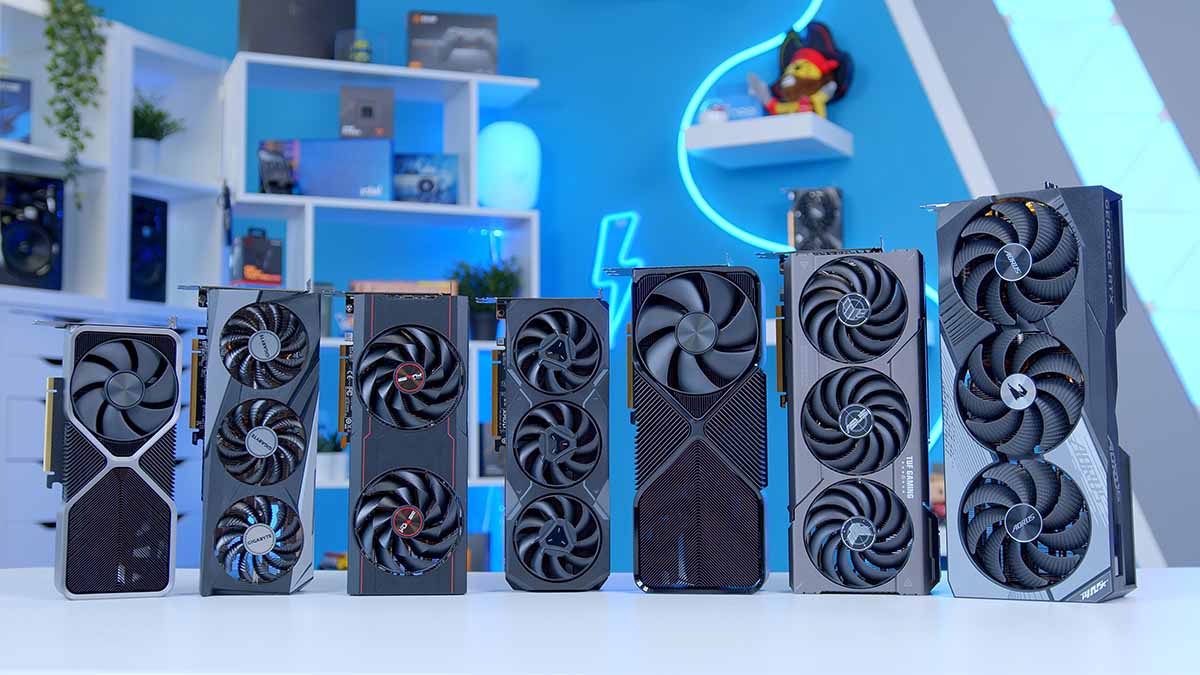June 2025 Benchmark Battle
The graphics card landscape in June 2025 is a thrilling, albeit complex, arena. New architectures from Nvidia (Blackwell), AMD (RDNA 4), and Intel (Battlemage) have become established, promising leaps in performance and AI capabilities. However, the familiar specters of pricing and availability continue to cast long shadows. This infographic cuts through the noise, offering a clear, benchmark-driven comparison of the latest and most popular graphics cards to help you find your next upgrade.
Understanding the Contenders: A Trio of Titans
Nvidia
Blackwell Architecture
The market leader continues to push boundaries with its RTX 50 Series, focusing on ultimate performance and advanced AI features like DLSS 4 with Multi Frame Generation and enhanced Ray Tracing.
AMD
RDNA 4 Architecture
A formidable competitor delivering strong performance-per-dollar with its Radeon RX 9000 Series. RDNA 4 significantly improves ray tracing and introduces the ML-based FSR 4 upscaler.
Intel
Battlemage Architecture
The newest entrant is making serious strides with its Arc B-Series. Battlemage focuses on driver stability, efficiency, and competitive mainstream performance with its XeSS 2 upscaling technology.
The Performance Hierarchy
Synthetic benchmarks provide a standardized way to measure the raw power of different GPUs. We look at 3DMark's Steel Nomad for modern rasterization performance and Port Royal for ray tracing capabilities to establish a clear ranking.
3DMark Steel Nomad Performance
A measure of modern rasterization performance (DX12). Higher is better.
3DMark Port Royal Performance
A direct test of ray tracing capability. Higher is better.
Real-World Gaming Gauntlet
How does synthetic power translate to actual frames? We tested key GPUs in today's most demanding titles at 1440p Ultra settings, the current sweet spot for high-fidelity gaming. First, we look at pure rasterization, then we enable demanding ray tracing.
1440p Ultra Rasterization FPS
Performance without any ray tracing or upscaling. Higher is better.
1440p Ultra Ray Tracing FPS
Performance with demanding ray tracing enabled (no upscaling). Higher is better.
The Upscaling Game-Changer
Raw performance is only half the story. Modern GPUs rely on AI-powered upscaling and frame generation to boost FPS. Here's how the big three's technologies stack up.
Nvidia DLSS 4
Core Tech: AI-powered Super Resolution, Ray Reconstruction, and Frame Generation.
Key Feature: Multi Frame Generation (MFG) uses a Transformer AI model and can generate up to 3 AI frames for each rendered frame, offering massive FPS boosts.
Hardware: MFG is exclusive to RTX 50 Series. Super Resolution and Ray Reconstruction work on all RTX cards.
Quality: Generally considered the leader in image stability and fine detail retention, though MFG can add latency.
AMD FSR 4
Core Tech: AMD's first Machine Learning (ML) based upscaler.
Key Feature: Significantly improved image quality over FSR 3, with better temporal stability and reduced ghosting. Includes frame generation.
Hardware: Exclusive to RX 9000 Series due to reliance on new AI Accelerators and FP8 processing.
Quality: A massive leap for AMD, making it highly competitive with DLSS in image quality, sometimes surpassing DLSS 3.
Intel XeSS 2
Core Tech: AI-enhanced upscaling using XMX AI Engines.
Key Feature: Now includes Frame Generation (XeSS-FG) and Low Latency (XeLL) features, making it a complete upscaling suite.
Hardware: Runs best on Arc B-series and newer. Super Resolution remains cross-compatible with other vendor GPUs.
Quality: Provides a valuable performance uplift with good image quality, especially for budget to mainstream cards.
Price vs. Performance: The Value Proposition
Which card gives you the most bang for your buck? This scatter plot maps the MSRP of each card against its Steel Nomad performance score. Cards in the top-left quadrant offer the best value.
Performance per Dollar (MSRP)
Based on Steel Nomad DX12 Graphics Score vs. Launch MSRP ($USD).
Conclusion & Gamer Recommendations
For the High-End Gamer & Enthusiast:
If budget is no object and ultimate performance is key, the NVIDIA RTX 5090 remains the undisputed champion. For a more balanced high-end choice, I recommend either RTX 4090 or RTX 5080.
For the Budget-Conscious & Mainstream Gamer:
This is a battleground. The RTX 5070 Ti ($749), RTX 5070 ($549), RX 9070 XT ($599), and RX 9070 ($549) are key players. The RX 9070 XT often matches or beats the more expensive RTX 5070 Ti in rasterization, and is very competitive in RT. Moreover you can go for RTX 4070 Ti Super ($799) and RTX 4060 Ti 16gb Variant.
Always check current street prices and recent, detailed reviews before making your final GPU decision. The market is dynamic!

